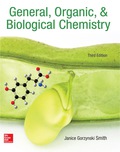
(a)
Interpretation:
The molarity of
Concept introduction:
The formula to calculate molarity is given as follows:
Answer to Problem 8.74P
The molarity of
Explanation of Solution
The formula to calculate molarity is given as follows:
The volume of solution in liters is given as
The number of moles of
Substitute the values in above formula to calculate the molarity of
(b)
Interpretation:
The molarity of
Concept introduction:
The formula to calculate molarity is given as follows:
The conversion factor to convert
Answer to Problem 8.74P
The molarity of
Explanation of Solution
The conversion factor to convert
Hence convert volume from
The volume of solution is given as
The number of moles of
Substitute the values in above formula to calculate the molarity of
(c)
Interpretation:
The molarity of
Concept introduction:
The formula to calculate molarity is given as follows:
The formula to calculate the number of moles from given mass is as follows:
Answer to Problem 8.74P
The molarity of
Explanation of Solution
The formula to calculate the number of moles of
Mass of
Molar mass of
Substitute the values in above formula to calculate the number of moles of
The conversion factor to convert
Hence, convert volume from
The volume of solution is given as
The number of moles of
Substitute the values in above formula to calculate the molarity of
(d)
Interpretation:
The molarity of
Concept introduction:
The formula to calculate molarity is given as follows:
The formula to calculate number of moles from given mass is as follows:
Answer to Problem 8.74P
The molarity of
Explanation of Solution
The formula to calculate the number of moles of
Mass of
Molar mass of
Substitute the values in above formula to calculate the number of moles of
The formula to calculate molarity is given as follows:
The volume of solution is given as
The number of moles of
Substitute the values in above formula to calculate the molarity of
Want to see more full solutions like this?
Chapter 8 Solutions
EBK GENERAL, ORGANIC, & BIOLOGICAL CHEM
 Introductory Chemistry: A FoundationChemistryISBN:9781337399425Author:Steven S. Zumdahl, Donald J. DeCostePublisher:Cengage Learning
Introductory Chemistry: A FoundationChemistryISBN:9781337399425Author:Steven S. Zumdahl, Donald J. DeCostePublisher:Cengage Learning Chemistry: The Molecular ScienceChemistryISBN:9781285199047Author:John W. Moore, Conrad L. StanitskiPublisher:Cengage Learning
Chemistry: The Molecular ScienceChemistryISBN:9781285199047Author:John W. Moore, Conrad L. StanitskiPublisher:Cengage Learning General, Organic, and Biological ChemistryChemistryISBN:9781285853918Author:H. Stephen StokerPublisher:Cengage Learning
General, Organic, and Biological ChemistryChemistryISBN:9781285853918Author:H. Stephen StokerPublisher:Cengage Learning World of Chemistry, 3rd editionChemistryISBN:9781133109655Author:Steven S. Zumdahl, Susan L. Zumdahl, Donald J. DeCostePublisher:Brooks / Cole / Cengage Learning
World of Chemistry, 3rd editionChemistryISBN:9781133109655Author:Steven S. Zumdahl, Susan L. Zumdahl, Donald J. DeCostePublisher:Brooks / Cole / Cengage Learning Living By Chemistry: First Edition TextbookChemistryISBN:9781559539418Author:Angelica StacyPublisher:MAC HIGHER
Living By Chemistry: First Edition TextbookChemistryISBN:9781559539418Author:Angelica StacyPublisher:MAC HIGHER





